Derawar Fort
In the Cholistan Desert of Punjab, Derawar Fort is an awe-inspiring sight. At over 1500 meters in length, its imposing majesty is enough to take your breath away. The Fort’s origins are a little mysterious, but it’s thought to have been built in the 9th century by a Hindu king named Rai Jajja Bhatti. Over the centuries, it was a defensive stronghold, a royal palace, and even a prison. It’s one of the biggest forts in Pakistan.
These days, Derawar Fort Bahawalpur is a popular tourist attraction, and for a good reason. Its stunning beauty and imposing presence are sure to leave you amazed. Derawar Fort Cholistan Desert is a World Heritage Site listed by UNESCO because of its historical and cultural significance.
If you’re ever in the area, visit this magnificent Fort and experience its magic firsthand.
Derawar Fort History
A Hindu Rajput king of the Bhati clan named Rai Jajja Bhati initially built Derawar Fort in the ninth century A.D. to tribute Rawal Deoraj Bhati, the ruler of Jaisalmer and Bahawalpur. The area was under the control of the Arab-run Emirate of Multan. The Fort’s previous names were Dera Rawal and Dera Rawar, respectively. With time, the Fort’s pronunciation changed to Derawar, now its official name.
Muhammad ibn Qasim, an Arab commander of the Umayyads, took control of the Fort in 711 CE. It was then governed by the Emirate of Multan, which Mahmud Ghaznavi had taken control of in 1008 AD while securing Punjab. The Ghurids, led by Muhammad Ghori, later conquered the Fort, which the Delhi Sultanate later annexed.
From the early sixteenth century to the late eighteenth century, the Mughals ruled over the Fort. The Shahotra tribe was driven out of the Fort in the 18th century by Muslim Nawabs of Bahawalpur. The Fort was later rebuilt in its current form in 1732 by the Abbasi ruler Nawab Sadeq Muhammad, but due to Bahawal Khan’s concerns at Shikarpur, it escaped their control in 1747. Nawab Mubarak Khan captured the Fort in 1804. Near a crumbling wall in the Fort, archaeologists discovered debris with 1,000-year-old catapult shells.
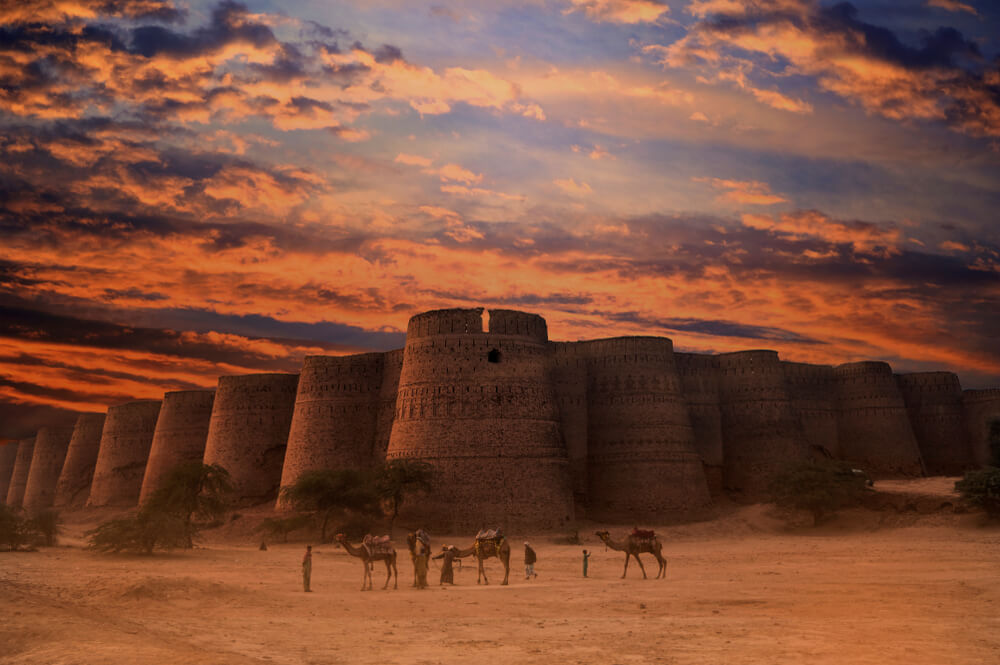
Nawab Sadeq Muhammad Khan Abbasi V, the 12th and final ruler of Bahawalpur State was born in Qila Derawar in 1904. His father died when he was only three years old, making him the new Nawab until 1966.
Derawar Fort Architecture
The Derawar Fort’s architecture is a picture of the mingling of cultures that the Mughals introduced to the Subcontinent. The pinnacle of the Mughal architectural style dates back to the first emperor and synthesizes Timurid, Persian, and Hindu customs.
Derawar shows the range of shapes that can find, from square brick structures with circular corner bastions to square walls. These walls are entirely faced with semi-circular towers to hexagonal and even rectangular compartments with angle bastions and square enclosures within an external perimeter with multiple fortifications.
Forty circular bastions, ten on each side, are visible for miles across the desert and stand 30 meters tall. Each one features intricate cut brickwork patterns as decoration. The Moti or Pearl Mosque and the Bahawalpur Nawabs’ cemetery are both close by, filled with elaborate and ornate graves. The remnants of structures inside the Fort have tile and fresco work.
There were offices, a small jail, gallows, a pond, and residential spaces on the ground floor. According to legend, nawab sahib would come to the Fort every Thursday and preside over an open court where he would decide on various cases, including those involving capital offenses.
Things to Bring to Visit Derawar Fort
Bring plenty of snacks and water as you make your way to Derawar Fort. The Fort is in the Cholistan Desert, so it can get quite hot, and you will feel thirsty!
In addition to water and snacks, you’ll want to ensure you wear sunscreen and comfortable clothing. The best time to visit the Fort is late evening or early morning when the sun isn’t as harsh.
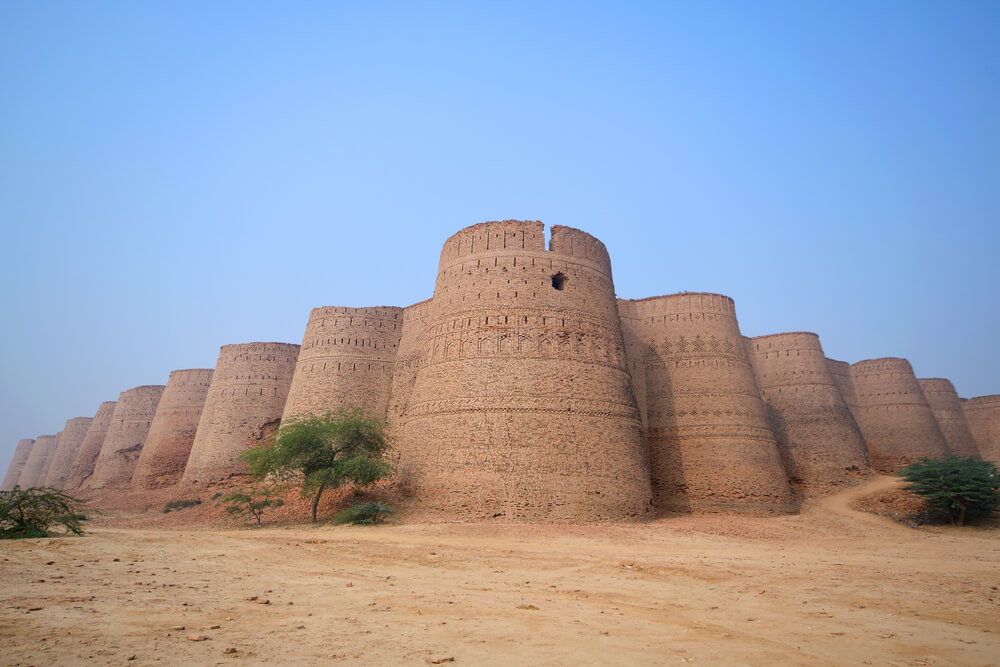
If you’re planning on spending a night at the Fort, you should also bring a camping or sleeping bag. No hotels near the Fort, so you’ll be roughing it if you stay overnight. But it’s all worth it to experience the Derawar Fort in all its glory!
Derawar Fort Attractions
When you visit Derawar Fort Bahawalpur, you’ll see some of the most majestic views in all of Punjab. The Fort is home to some fascinating attractions, including an ancient mosque and a stunning collection of murals. And don’t forget to check out the Fort’s imposing walls and attractive gates! In the winter, the Fort draws many visitors from all over the world.
Let’s have an in-depth look at some of the most impressive attractions.
Cannons Used by Bahawalpur Army
If you’re visiting Qila Derawar, check out the Cannons used by the Bahawalpur Army display. Their army used these cannons to defend the Fort against invading armies.
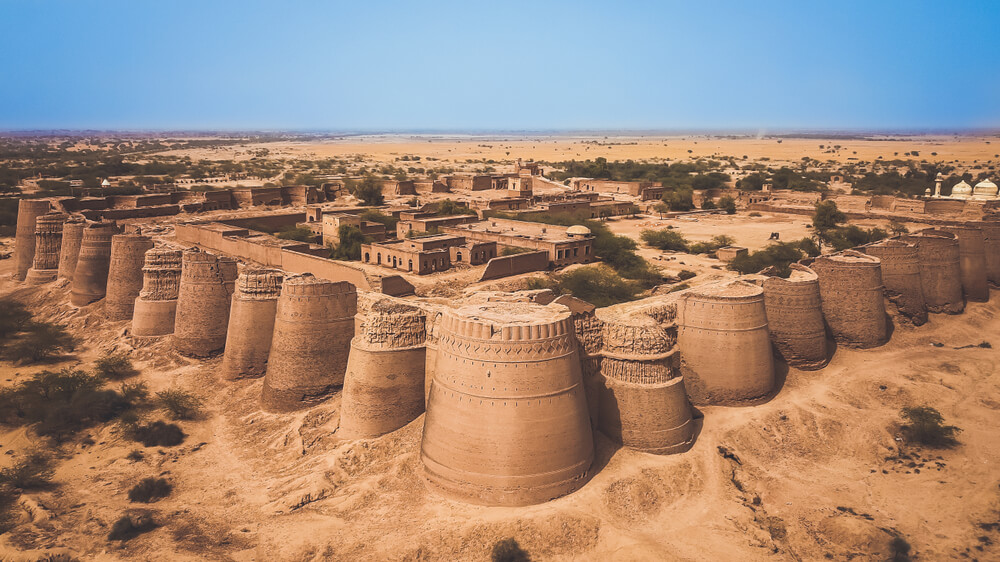
The display features several cannons, some more than 100 years old! It’s incredible to see how technology has evolved over the years, and it’s an excellent opportunity to learn.
Underground Railway Tunnel
In Qila Derawar, you’ll come across an underground railway tunnel that transports goods and supplies in and out of the Fort. It’s a fascinating piece of history, and it’s incredible to think about how people used this tunnel so long ago!
Network of Tunnels Leading to other Forts
Fort Derawar has some open tunnels on the ground floor, famous for its underground tunnels. This fortress’s history reveals the reason and intent behind building these underground passages. Royal families used these tunnels to flee and save their lives when enemies attacked them during battles.
The Cholistan is home to numerous other historic forts, including Marogarh, Khairgarh, Islamgarh, Dingarh, Meergarh, and Maujgarh, in addition to Derawar.
Since Qila Delaware’s tunnels connect to each of these forts, it appears that a web of secret passages connects the Cholistan as a whole. Aside from this, the Derawar Fort’s underground tunnels connect all the palaces in Bahawalpur State.
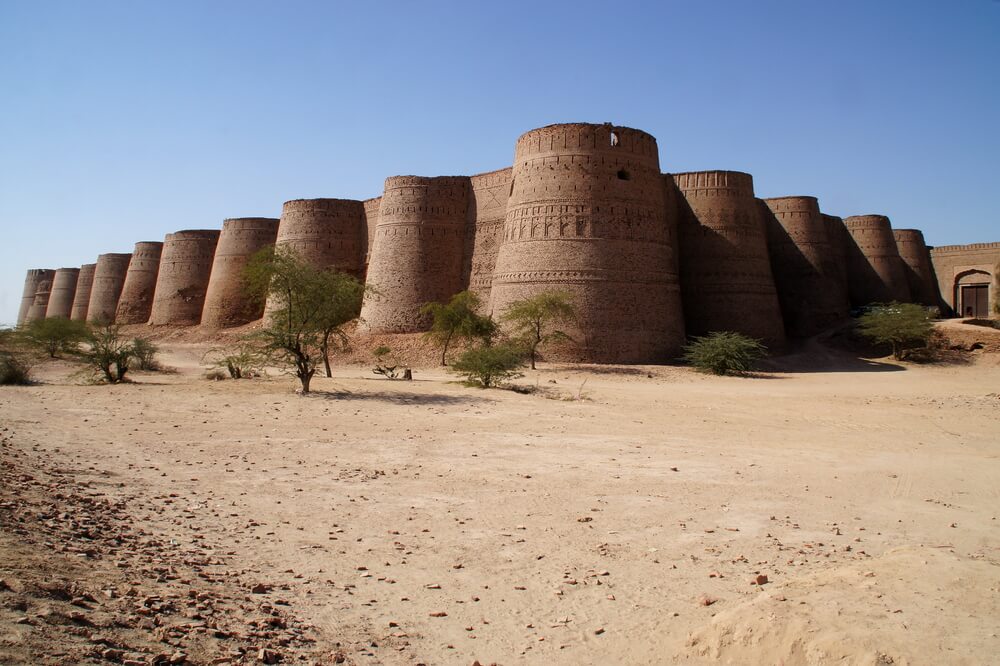
Even the Fort’s basements, once accessible via a staircase made of tunneled passageways, have a unique architecture. This sizable underground railway tunnel also connects Sadiq Garh Palace and Derawar Fort Cholistan Desert.
Ancient Dry River
The Thar desert of the Indian Subcontinent, located in contemporary Pakistan, has a western section called the Cholistan desert, or Rohi. Archaeological findings show that an Indus Valley culture with an agricultural economy once lived in this region irrigated by the Hakra River. From approximately 4000 BC until 600 B.C., when the river’s flow changed and eventually disappeared underground, this river, whose bed is visibly etched into the desert landscape, provided settlement support. Since then, the Cholistan region has been an arid, hostile desert environment on the periphery of empires. After the river dried up, the area underwent desertification, with only grazing lands left.
Cholistan Desert
If you are looking for an epic experience, look no further than the Cholistan Desert! This vast and otherworldly landscape is home to some of Pakistan’s most impressive historical sites, including the majestic Qila Derawar.
The Greater Thar Desert, which includes Sindh province and the Indian state of Rajasthan, consists of the Cholistan Desert in southern Punjab, Pakistan. The Cholistan was once a large river basin formed by the waters of the Sutlej and Yamuna Rivers, though it is now a dry area.
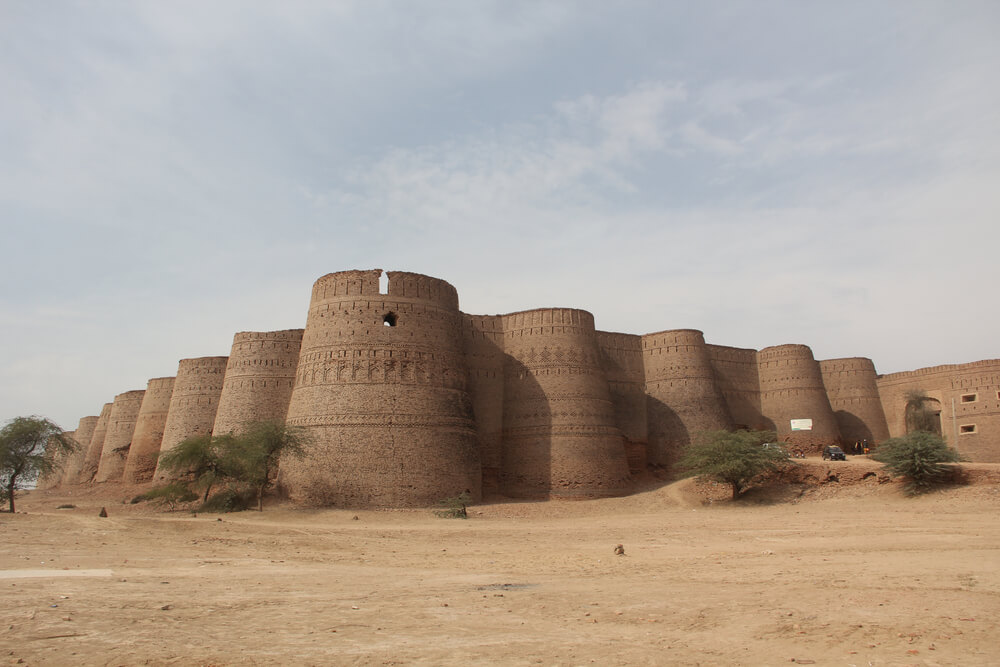
Cholistan has a significant concentration of prehistoric settlements from the Indus Valley period dating back to 4000 BCE. It was a fertile area with a large river fed by Himalayan meltwater in ancient times. Later, the region was a hub for caravan trade, which led to the construction of many forts during the medieval era to guard trade routes—the Derawar Fort Bahawalpur being the best-preserved example.
Mode of Life in the Cholistan Desert
The average annual rainfall in the desert is only 12 cm (5 inches), and there is hardly any habitation. The water underground is brackish. The few inhabitants of the desert create artificial wells in the depressions between the sand hills and draw water up from them using camels.
They create artificial ponds during the rainy season, and when those ponds dry up, they leave the desert. The inhabitants of the desert reside in tall, steeple-shaped huts built on the highest sand hills and block most of the sun. Graceful Lean women wear long, gathered red skirts. They make a living by breeding camels and raising cattle. Derawar is home to the private breeding camel herds of the Amir. The Bahawalpur Museum contains some excellent images of the nomads’ way of life.
The Cholistan Desert is a must-see for any traveler to Pakistan. It’s a fantastic place to explore and home to some of the country’s most friendly people.
Jeep Rally
The desert of Cholistan hosts a Jeep Rally each year. The Jeep Rally is so well-known that spectators and competitors travel from all over the world to attend. The TDCP organizes a Cholistan rally in Pakistan. The first rally took place in 2005 and has become one of the nation’s most watched and eagerly awaited events. Over 100,000 people travel to the desert each year to attend the festival. Some Pakistani local channels are streaming this Jeep rally live. Coming here to watch the Cholistan Jeep Rally in Bahawalpur is worth every penny.
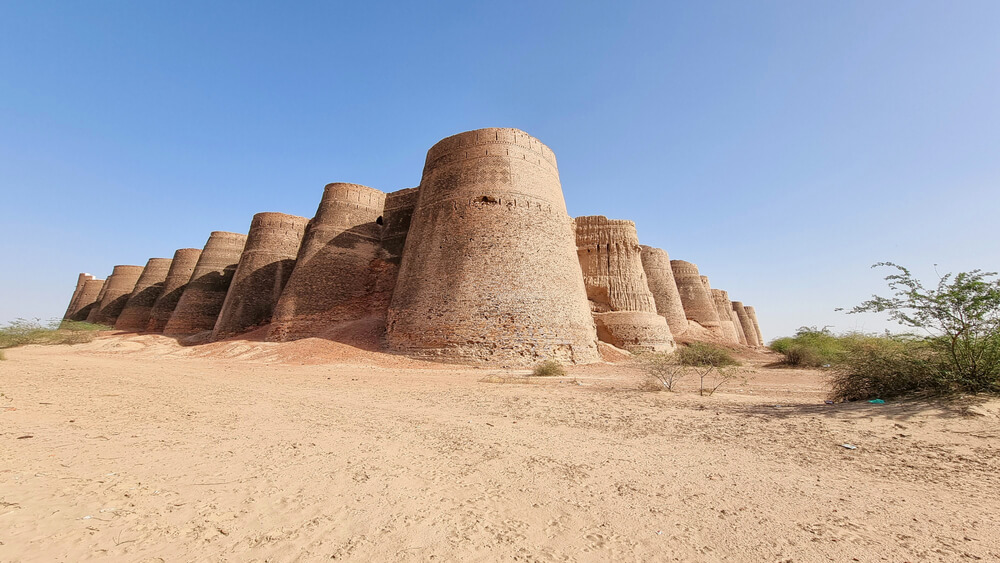
Derawar Fort Damages
The Fort’s interior offers an entirely different perspective on events. Almost every wall inside the building has been harmed by the ferocious weather or the crowds of tourists. Additionally, the woodwork is deteriorating as well. With time, most wooden carvings have disappeared. The Fort’s interior floor is similarly in disarray.
Visitors used to be able to descend by stairway to the underground area, but now it is not possible due to blocked tunneled pathways. If authorities didn’t take action, the entire Fort might collapse due to its dilapidated state. Tragically, visitors are also at fault because they carelessly walk on different buildings, eat nearby, and throw trash into the Fort.
Derawar Fort Cholistan Desert was in excellent condition just ten years ago. Visitors saw a network of tunnels leading to various rooms as they walked through the tunnels for about a mile. However, the stairs that led to the top of the bastions have now given way. Bricks from some of the fortifications have fallen off due to most of them developing cracks.
Renovation of Derawar Fort
The provincial government has allocated Rs 100 million for the project, and the centuries-old Derawar Fort’s renovation and repair work has already begun. The money was given in light of the yearly international Jeep rally in the area and has gained much attention from the media abroad.
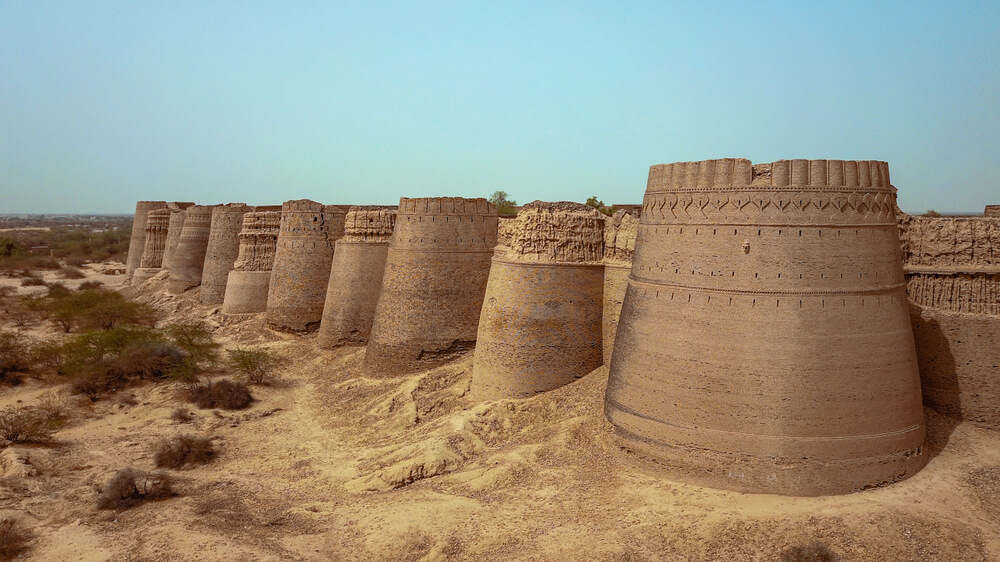
Interesting Facts about Derawar Fort
- Qila Derawar Fort took only three years to construct. This Fort is one of the quickly and precisely built strongest forts and military bastions ever made by humankind.
- Dera Rawal was Derawar Fort Bahawalpur’s original name, derived from the Arabic word Darwaza, which means door. Some people hypothesized that it came from Bahawalpur’s earliest name, Dara-I-Noor.
- The tremendous walled enclosure at Derawar was probably first built during the rule of Rai Jajja Bhatti I (873–918 AD), but Raja Dahir II (933–973 AD) was the one who finished it.
- There were 29 attacks on the Qila Derawar. Foreign and Sindhi armies frequently launched attacks; the fort and local lords suffered consequences. Mian Ghulam Shah Kalhoro and his son Mir Masum Shah Kalhoro were primarily responsible for the gates’ damage, even though British engineers modified them in 1839 and 1842. Despite these attacks, the Fort’s walls and gates are in excellent shape and stand tall.
- Due to its military design, Derawar Fort is one of Pakistan’s most important forts. There are numerous palaces, mosques, and temples inside the Fort, with six gates. A water tank in the center of the fortress is still in use.
- The interior of the Derawar Fort Bahawalpur walls is five feet thick.
- The fort enclosures cover about 25 acres in total has four bastions surrounding the outer chamber of the central citadel, which has three terraces.
- During the British era, Derawar Fort Bahawalpur served as a prison and the site of the hanging of some unfortunate prisoners.
- In Pakistan, Qila Derawar has appeared in two well-known music videos: the first, Yeh Shaam by The Vital Signs, and the second, Shor Macha by Entity Paradigm.
Nearby Attractions of Derawar Fort
Derawar Fort Bahawalpur also houses the tombs of the Amirs of Bahawalpur, decorated with blue glazed tiles that stand out against the ochre surroundings. Let’s look at some of the nearby attractions of Derawar Fort Cholistan Desert.
Abbasi Mosque
In the Cholistan Desert of Bahawalpur District, Punjab province of Pakistan, close to Derawar Fort in Yazman Tehsil, is a mosque known as the Abbasi Mosque. In 1849, Nawab Bahawal Khan constructed it. The Moti (pearl) Masjid in Agra, built by Shah Jahan, inspired the design of this stunning white marble mosque. It still belongs to the Abbassi family and is a piece of the historical residence of the former Nawabs of Bahawalpur.
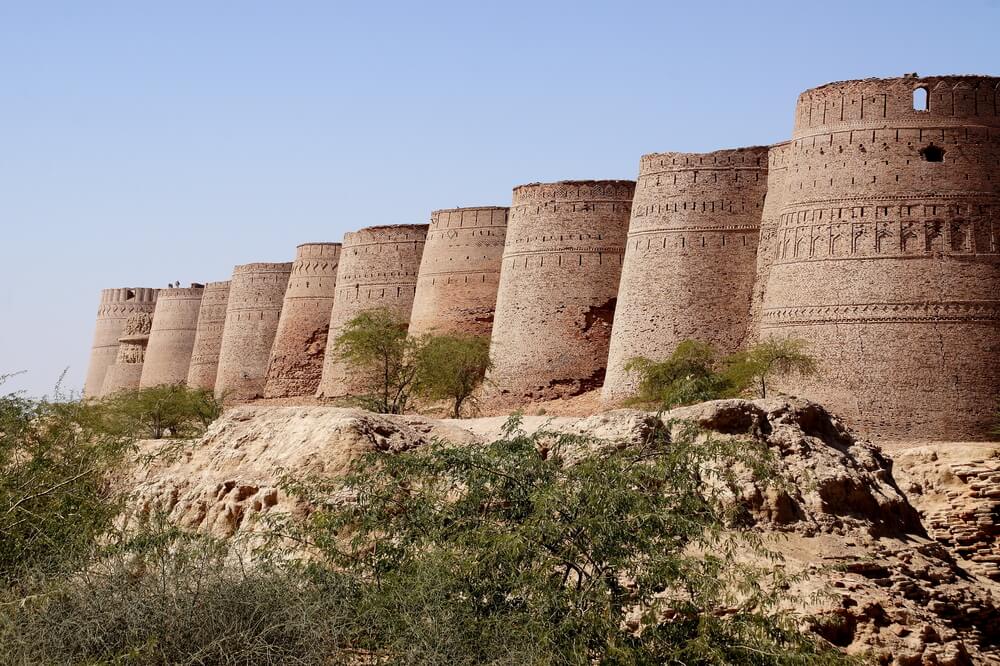
Royal Graveyard
It is a short distance from Abbasi Masjid. The previous Nawabs are all buried here, and the Abbasi family was the dominant Nawab family in Bahawalpur. According to legends, this graveyard also contains the tombs of the Holy Prophet’s (PBUH) companions.
The Nawabs family members who are still alive still own and run the cemetery.
Camping under the Starry Sky of the Cholistan Desert
Imagine this: you’re camping out under the starry sky of the Cholistan Desert, just a few kilometers away from the majestic Derawar Fort. It is a clear night, and the stars are full of force. You can see billions of them shining down on you with utter brilliance.
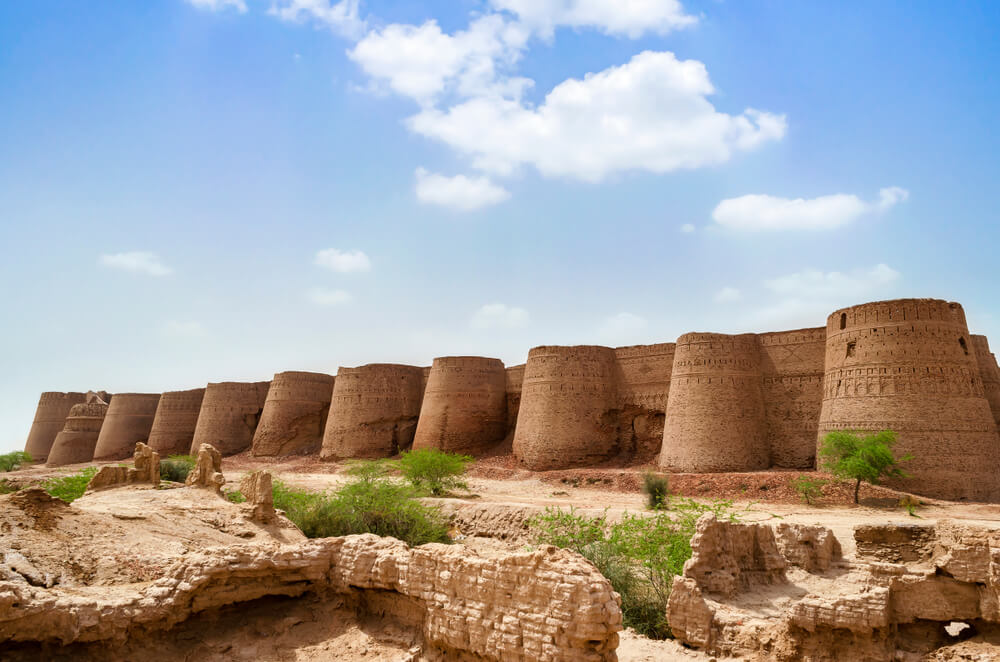
The desert is so peaceful and quiet at night, and the air is warm and still. You can hear the occasional cricket chirping or breeze blowing through the nearby palm trees. It’s magical, and you’ll never forget it.
How to Reach Derawar Fort?
A well-known landmark of Bahawalpur, the Derawar Fort stands erect in the Cholistan Desert. You require a driver to take you to Derawar Fort Bahawalpur and authorization from the current Amir of Bahawalpur to enter the Fort. The journey through the captivating desolate landscape takes three to four hours. The Cholistan Desert is 26,000 square kilometers (10,000 square miles) in size and stretches into the Thar Desert in India. However, the trip to the Fort is exhausting, lengthy, and covered in dust.
Derawar Fort Location
In Punjab, Pakistan’s Ahmadpur East Tehsil, there is a fort called Qila Derawar. The forty bastions of Derawar can be seen for many miles in the Cholistan Desert, about 20 km south of Ahmedpur East. The walls are up to 30 meters high and have a 1500-meter perimeter.
Frequently Asked Questions
What was the Old Name of Derawar Fort?
Dera Rawal was the original name of Derawar Fort Bahawalpur, which came from the Arabic word for door, Darwaza. Some people hypothesized that it came from Bahawalpur’s earliest name, Dara-I-Noor. It eventually came to be known as Dera Rawar. With time, the name’s pronunciation changed to Derawar, the term we use today.
Why is Derawar Fort famous?
One of Pakistan’s most famous historical fortresses, Derawar Fort Bahawalpur, sits in the center of the country’s largest Cholistan desert (Rohi) and serves as a symbol of various civilizations and a remarkable history. This Fort was regarded as one of the most impressive defensive forts and was also mentioned in numerous historical battles. Despite this, the abandoned buildings and dark, unsealed basements make the place creepy.
How old is Derawar Fort Cholistan Desert?
Derawar Fort Bahawalpur has been standing for more than 1,000 years, and it’s seen a lot of action in that time. It’s a true Clash of Empires monument!
Why was Derawar Fort built?
Approximately 800 years ago, the Derawar fort’s foundation stone was laid based on historical records. But in 1733 A.D., the Nawabs of Bahawalpur took control of it and completely rebuilt it. The Bahawalpur Nawab lost control of the Fort just a few years later due to unrest in the surrounding area. However, they took back the Fort in the nineteenth century and stayed in the region along with a stronghold.
Conclusion
Derawar Fort is one of the most majestic forts in all of Pakistan. The Fort has a rich and long history, dating back to the 9th century. Over the centuries, it has undergone numerous reconstructions and additions, but today it still stands as a testament to the engineering prowess and skill of those who constructed it. The Derawar Fort Bahawalpur is also a popular tourist destination, and visitors worldwide come to see its massive walls and beautiful architecture.
If you ever have the chance to visit Pakistan, be sure to add Derawar Fort to your itinerary. You won’t regret it!
